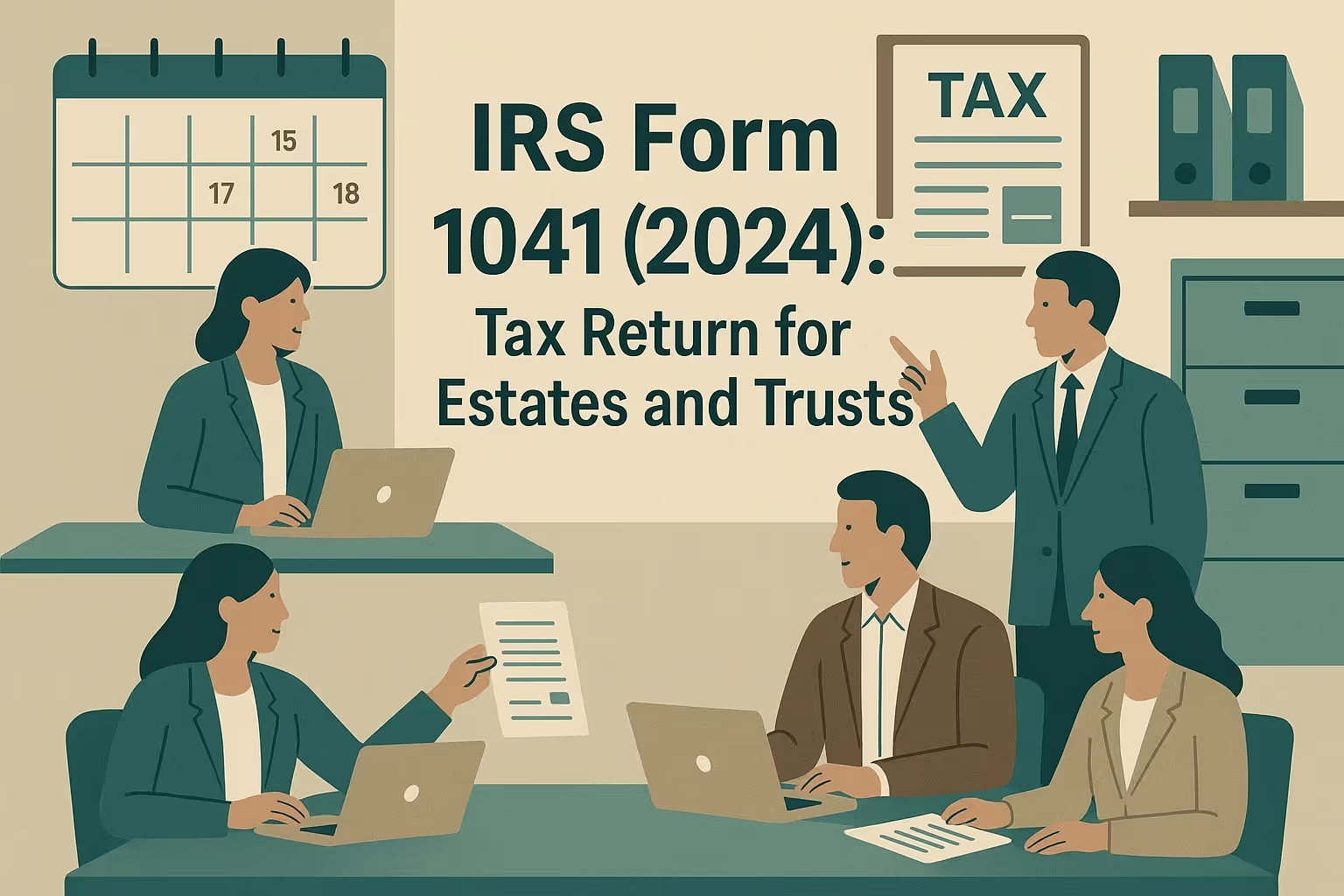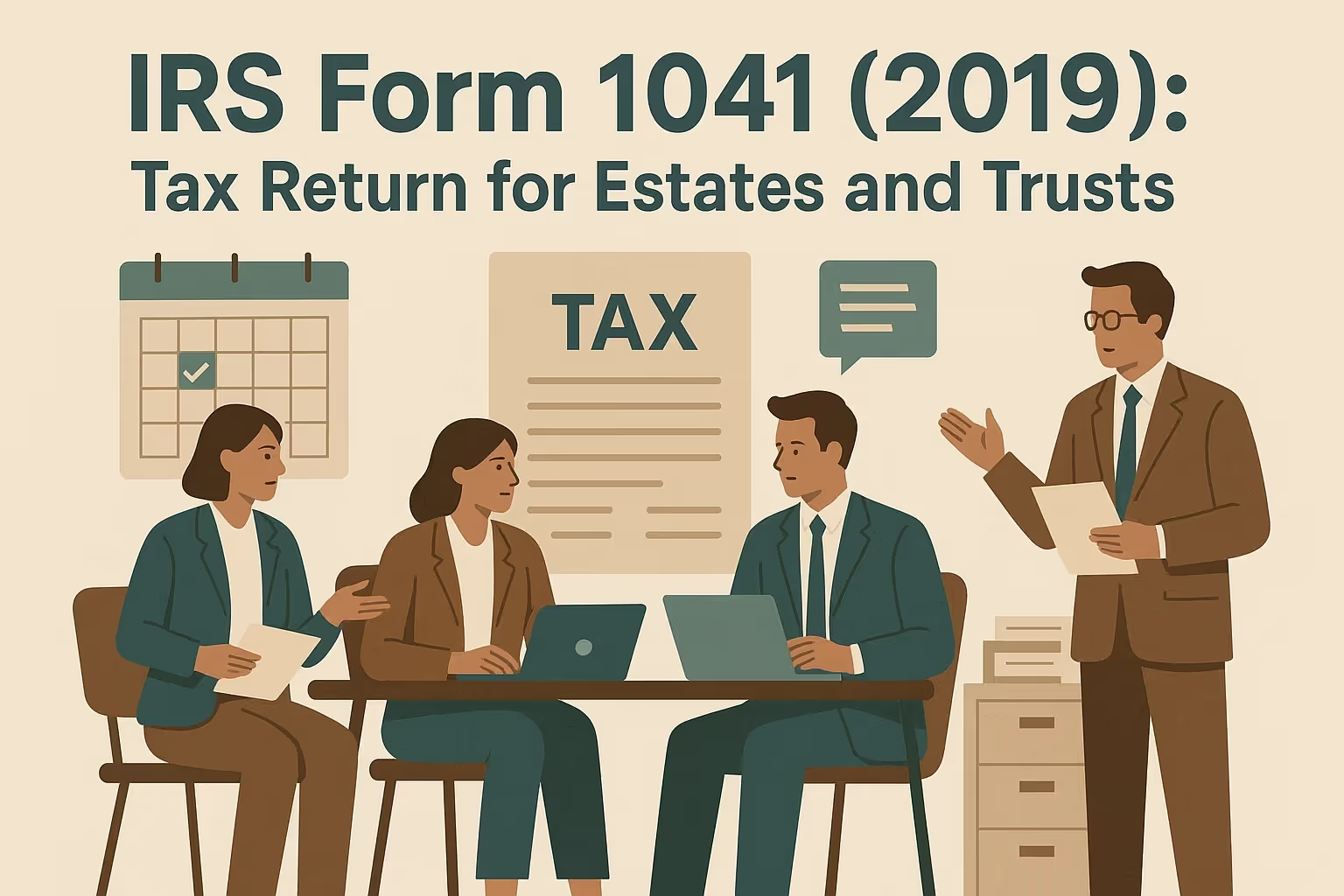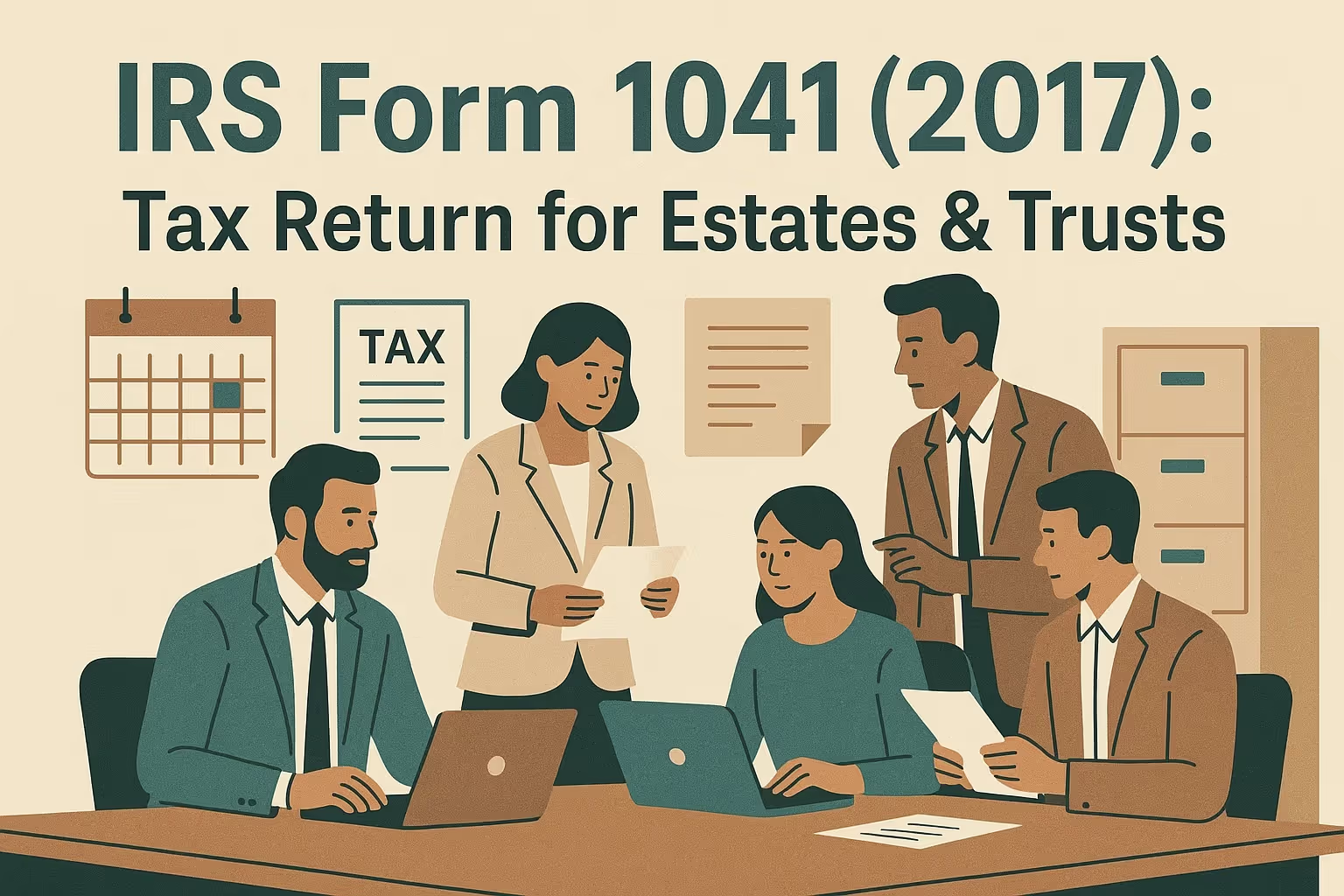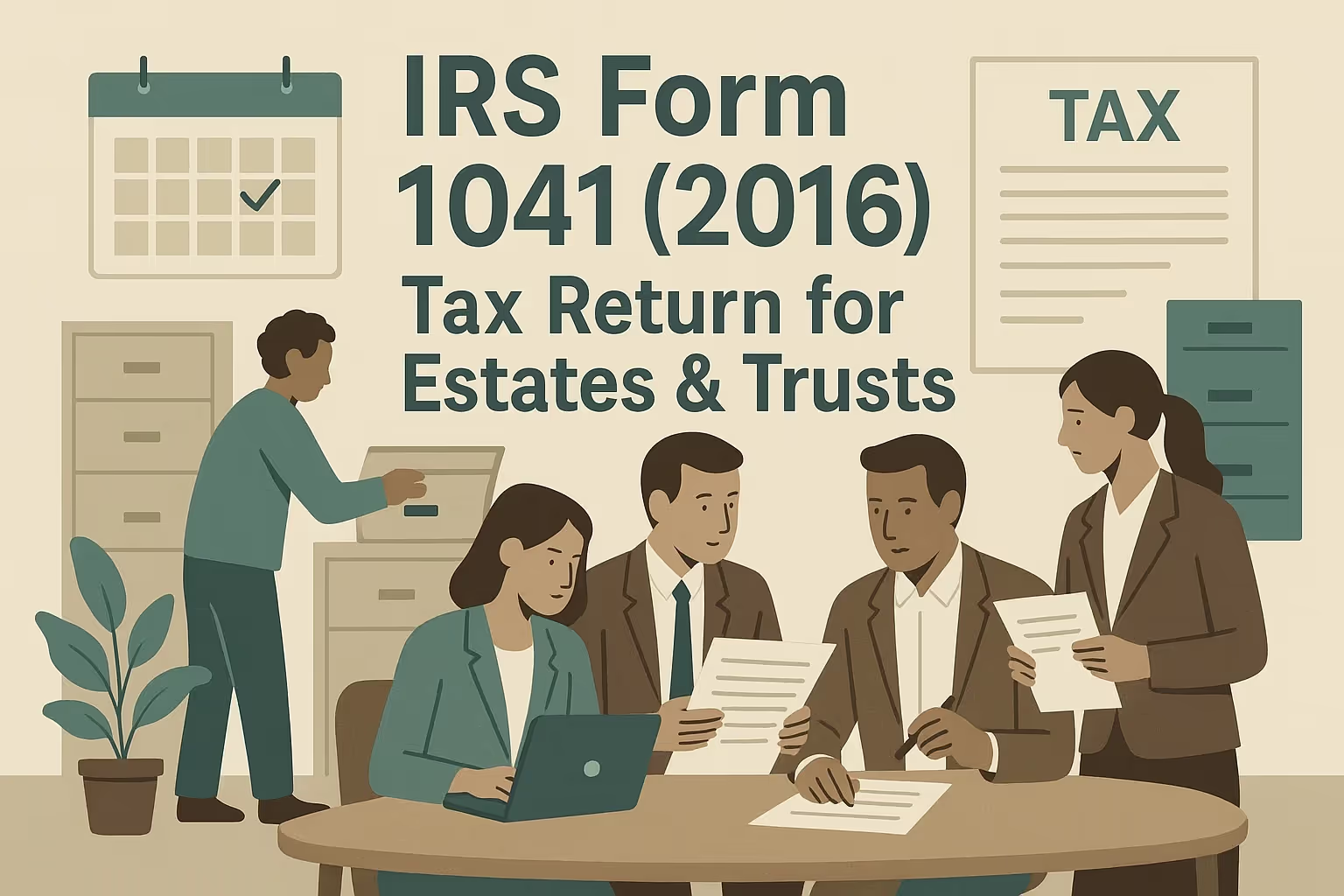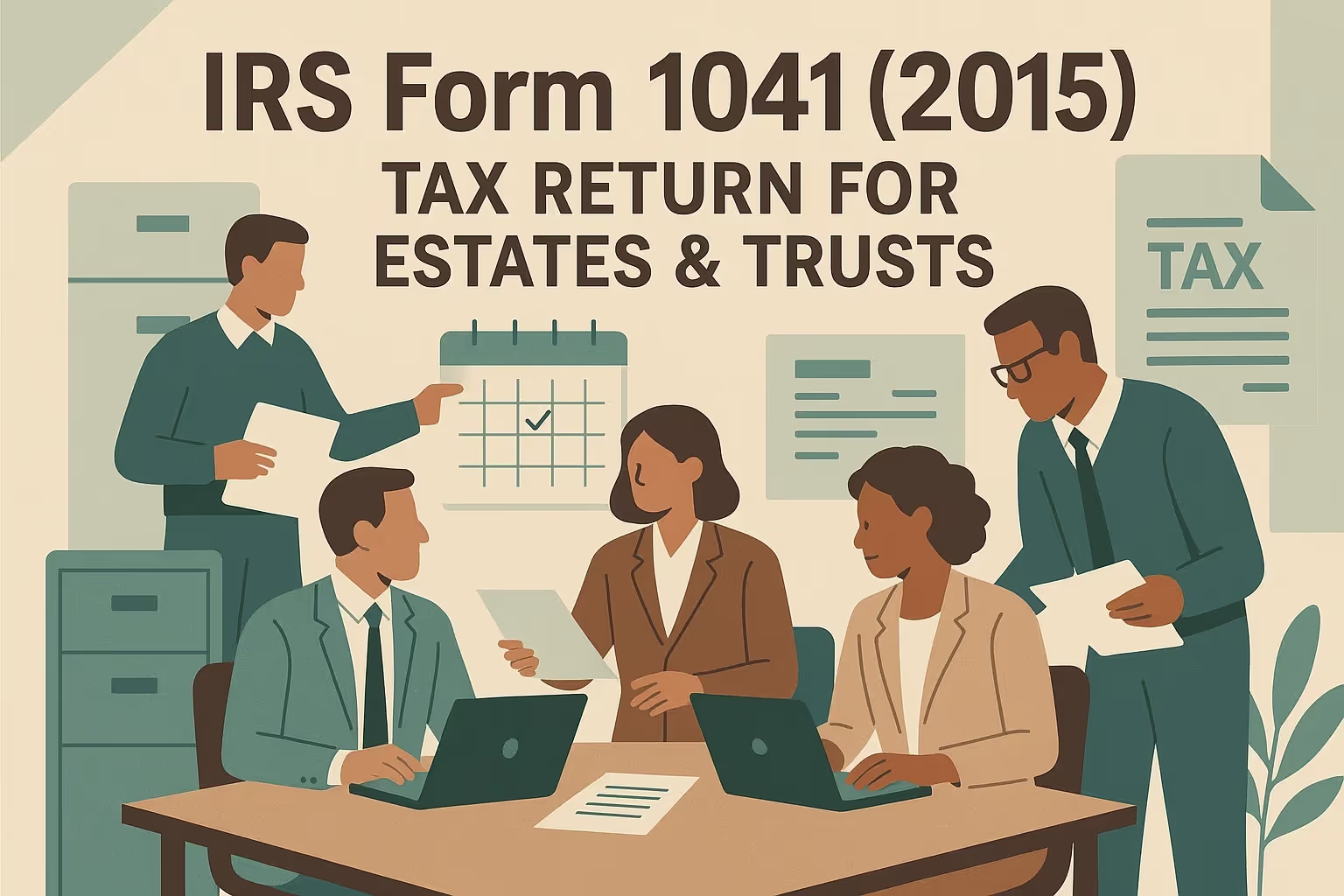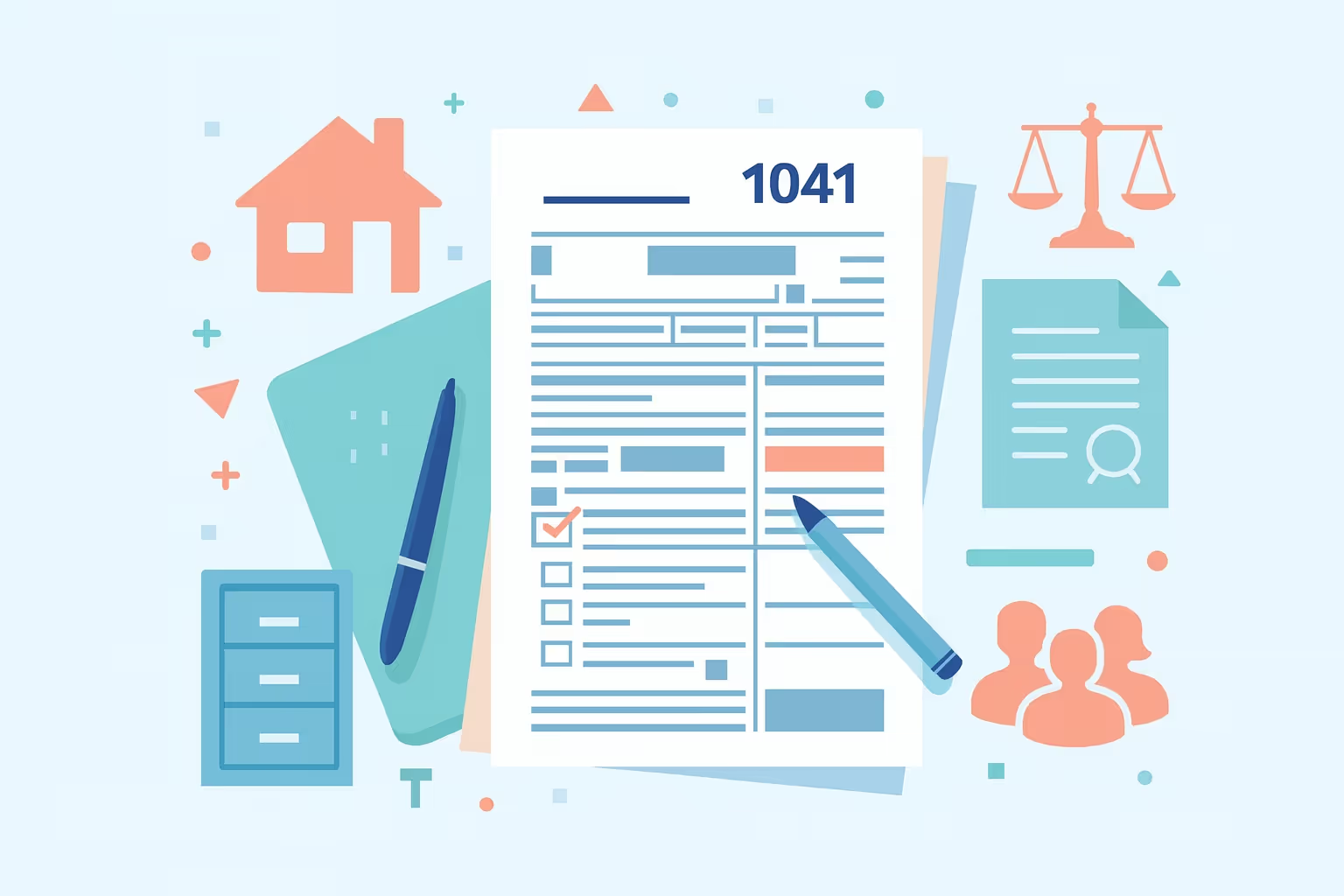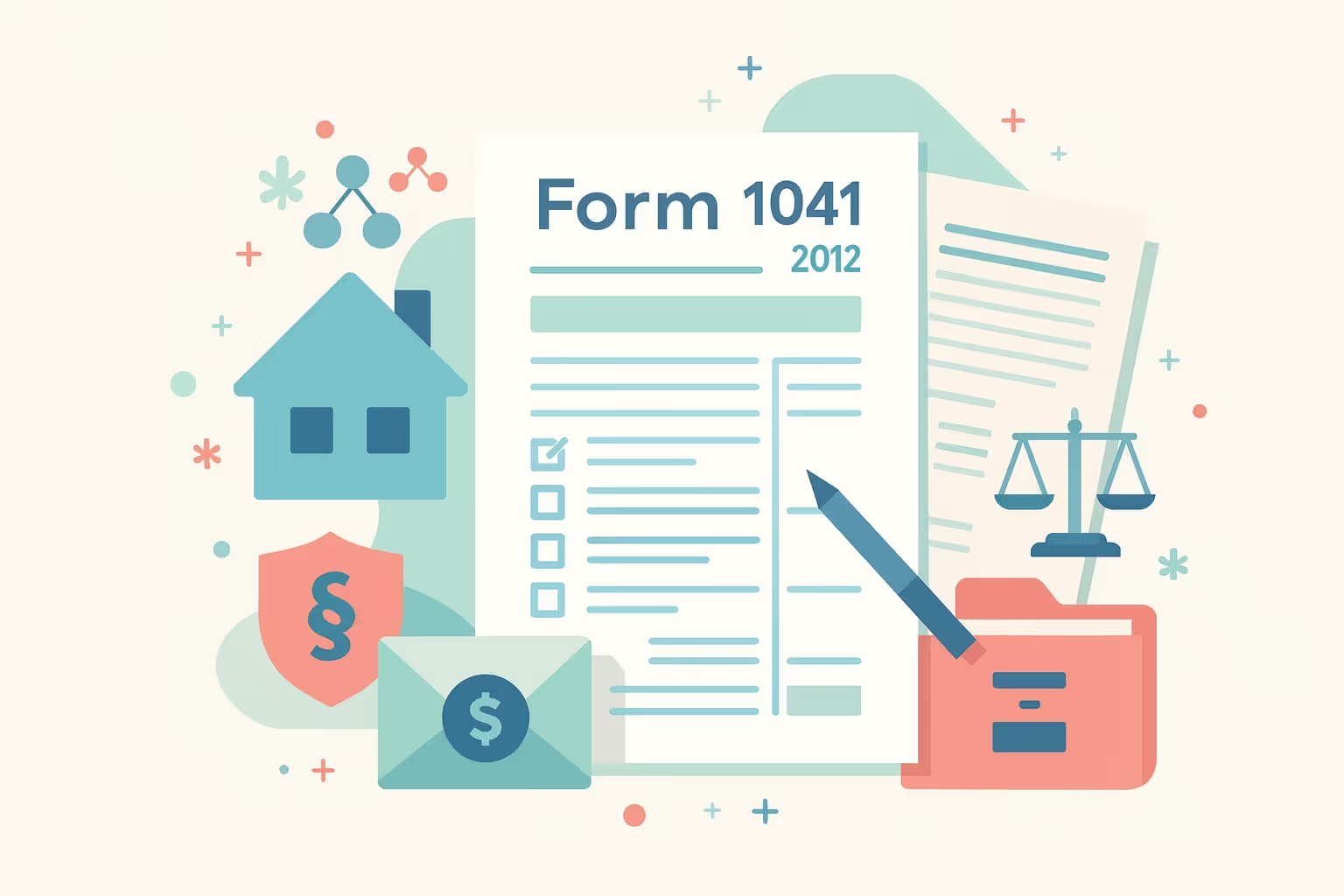Form 1041 2019 Instructions: Estate and Trust Filing Guide
Form 1041 is the official income tax return that fiduciaries use to report income, deductions, and distributions for estates and trusts. It is filed with the Internal Revenue Service by a personal representative or trustee who manages income generated after an individual’s death. This filing ensures that the estate or trust meets federal tax return obligations and accurately reports any income, deductions, or payments related to its administration during the tax year.
For the 2019 tax year, the IRS established specific filing requirements and due dates that fiduciaries must follow to remain compliant with the tax laws. The form covers details such as gross income, taxable income, and income tax liability, ensuring that all earnings and distributions are correctly accounted for. Understanding the purpose and structure of Form 1041 helps fiduciaries exercise primary supervision and fulfill their responsibilities in accordance with the Internal Revenue Code.
This guide provides clear, step-by-step instructions for Form 1041 2019, specifically for those managing estates and trusts. It explains how to determine when filing is required, how to report income and deductions, and which schedules or attachments must be included. Designed for readers unfamiliar with tax procedures, this guide simplifies complex reporting rules, enabling fiduciaries, executors, and trustees to complete their tax returns confidently and in compliance with IRS regulations.
Understanding Form 1041 and Who Must File?
Form 1041, U.S. Income Tax Return for Estates and Trusts, is a federal tax return used by fiduciaries to report income, deductions, and distributions for estates and trusts. It ensures that any income generated after an individual’s death is correctly reported to the Internal Revenue Service. Fiduciaries, such as executors or trustees, are responsible for filing this form when specific income or beneficiary conditions are met.
Purpose of Form 1041
Form 1041 allows the fiduciary of an estate or trust to report the following:
- The income earned or accumulated during the tax year.
- The income is distributed to beneficiaries, and related deductions are applied.
- The estate’s or trust’s total income tax liability.
- Any applicable employment taxes or additional federal taxes.
Filing Requirements for Estates and Trusts
Filing obligations depend on the type of entity and the amount of income generated.
- Domestic Estate – Must file if it has gross income of $600 or more during the tax year or if any beneficiary is a nonresident alien.
- Domestic Trust – Must file if it has any taxable income, gross income of $600 or more, or a nonresident alien beneficiary.
- Foreign Estate or Trust – May have filing requirements if it receives income from U.S. sources or engages in business within the country.
Determining Who Is a Fiduciary
A fiduciary is a person or entity that manages property or income on behalf of another, such as a personal representative, executor, or trustee. When there are joint fiduciaries, each person involved in substantial decisions shares responsibility for ensuring the proper filing of the tax return. The fiduciary must also exercise primary supervision over the administration of the estate or trust and maintain accurate records of income and expenses.
Key Considerations for Filing
- A valid employer identification number must be used on the return instead of the decedent’s Social Security Number.
- The filing entity must determine whether it qualifies as a domestic or foreign trust based on the control test and court test.
- Fiduciaries must confirm whether the filing is for a calendar-year or fiscal-year entity.
- Estates and trusts must comply with the Internal Revenue Code and maintain all supporting documentation for deductions and distributions.
Fiduciaries who understand these basic rules can ensure that the estate or trust remains compliant with federal tax laws. Proper filing of Form 1041 helps prevent penalties, provides accurate reporting of income distribution deduction and taxable income, and demonstrates compliance with IRS requirements.
Due Dates, Filing Requirements, and Automatic Extensions
The Internal Revenue Service requires estates and trusts to file Form 1041 by a specific deadline based on their accounting period. For the 2019 tax year, the due date for calendar-year filers was April 15, 2020. Fiduciaries using a fiscal year must file by the 15th day of the fourth month after the close of their fiscal year. If the due date falls on a weekend or federal holiday, the deadline is extended to the next business day.
Filing Deadlines
- Calendar-Year Filers: File Form 1041 by April 15 following the close of the tax year.
- Fiscal-Year Filers: File by the 15th day of the fourth month after the end of the fiscal year.
- Business Day Adjustment: If the due date falls on a weekend or holiday, it moves to the next business day.
Requesting an Automatic Extension
Fiduciaries who need more time to file may request an automatic extension by submitting Form 7004, Application for Automatic Extension of Time to File Certain Business Income Tax, Information, and Other Returns. This provides an additional five and a half months to file the income tax return. However, the extension applies only to filing—not to paying taxes owed. Any unpaid balance must be paid by the original due date to avoid penalties and interest.
Key Reminders for Filing on Time
- Verify whether the filing is for a calendar year or a fiscal year.
- Ensure the correct date falls within the applicable tax year.
- Pay any outstanding income tax liability before the original due date.
- Maintain documentation showing when the extension request was filed and accepted by the IRS.
Meeting the correct due date and filing requirements helps the fiduciary avoid unnecessary penalties and ensures compliance with the Internal Revenue Code.
What’s New for the 2019 Filing Year?
The 2019 tax year introduced several significant changes that affected how fiduciaries filed Form 1041 for estates and trusts. Understanding these updates helps ensure proper reporting of income, deductions, and credits on the return.
Key Updates for 2019
- Qualified Business Income Deduction (QBI): A new reporting line was added to Form 1041 for QBI deductions, allowing estates and trusts to claim qualified business income under Section 199A.
- Qualified Opportunity Fund Reporting: Fiduciaries holding a qualified investment in a qualified opportunity fund were required to include Form 8997, Initial and Annual Statement of Qualified Opportunity Fund Investments.
- Disability Trust Exemption: The maximum exemption amount for a qualified disability trust increased to $4,200.
- Capital Gains Tax Brackets: Estates and trusts were subject to updated 2019 capital gains rates of 0%, 15%, and 20% based on taxable income.
- Extended Tax Benefits: Legislation reinstated certain deductions and credits, including the mortgage insurance premium deduction and the biofuel producer credit.
These updates were intended to align trust and estate reporting with changes made by the Tax Cuts and Jobs Act and other federal tax provisions. Fiduciaries should review the official IRS instructions to ensure all new reporting and deduction rules are followed accurately.
Step-by-Step 2019 Form 1041 Filing Instructions
Filing Form 1041 requires careful attention to each section of the return. The steps below outline the process fiduciaries should follow to complete the form accurately for the 2019 tax year.
Step 1 – Gather Key Information and Tax Forms.
Before starting, fiduciaries must collect all necessary documentation, including:
- Employer identification number for the estate or trust.
- The will, trust agreement, or related legal documents.
- Financial records from banks and other financial institutions.
- Statements of income earned, such as 1099s, K-1s, or W-2s.
- Records of deductible expenses and distributions.
Step 2 – Complete Entity Information.
At the top of Form 1041, provide basic entity details, including:
- Type of entity (estate, domestic trust, or foreign trust).
- Employer identification number.
- Name, address, and date of creation.
- Name and title of the fiduciary exercising primary supervision.
- Tax year or fiscal year being reported.
Step 3 – Report Income.
The fiduciary must report all income generated during the tax year, including:
- Interest, dividends, and other investment income, which represent earnings from financial accounts and investments.
- Business income or loss, which reflects profits or losses from operations conducted by the estate or trust.
- Capital gains or losses, which result from the sale or exchange of property or other assets.
- Rental or royalty income, which arises from the use of real estate or intellectual property.
- Any other taxable income applicable to the estate or trust.
Step 4 – Report Deductions.
Allowable deductions may include:
- Interest and taxes paid by the estate or trust.
- Fiduciary fees and administrative expenses incurred in managing the estate or trust.
- Professional fees paid to attorneys, accountants, or tax preparers.
- Income distribution deductions for amounts distributed to beneficiaries.
- Other permissible deductions are allowed by federal tax law.
Step 5 – Determine Taxable Income and Tax Liability.
Subtract total deductions from gross income to determine taxable income. Fiduciaries must calculate the estate’s or trust’s income tax liability using the IRS tax tables for 2019. Additional taxes, such as the alternative minimum tax or net investment income tax, must also be considered.
Step 6 – Report Payments and Credits.
All estimated tax payments made throughout the year should be entered, along with any overpayments from prior years or tax credits applied.
Step 7 – Attach Schedules and Supporting Forms.
Depending on the type of income and deductions claimed, attach the appropriate schedules and forms, such as:
- Schedule A is used for charitable deductions.
- Schedule B, which reports income distribution deductions.
- Schedule D, which reports capital gains and losses.
- Schedule K-1, which shows each beneficiary’s share of income, deductions, and credits.
- Form 8960, which reports the net investment income tax.
- Form 8997, which reports qualified opportunity fund investments.
Completing Form 1041 accurately ensures that the estate or trust meets its federal tax obligations and avoids errors that could delay processing or trigger penalties.
Payment Requirements and Estimated Tax Rules
Fiduciaries are responsible for making timely tax payments on behalf of the estate or trust. Estimated income tax payments may be required if the entity expects to owe $1,000 or more in taxes after accounting for withholding and credits. These payments help avoid penalties and ensure that income taxation occurs evenly throughout the year.
When are Estimated Tax Payments Required?
Estates and trusts must generally make estimated payments if:
- The total expected income tax liability for the year is $1,000 or more.
- Withholding and credits are expected to be less than 90% of the current year’s tax or 100% of the prior year’s tax.
- The entity has substantial income generated from investments or property.
Payment Schedule for 2019
For calendar-year filers, estimated payments were due on the following dates:
- April 15, 2019
- June 17, 2019
- September 16, 2019
- January 15, 2020
Fiduciaries were not required to make the final January payment if the Form 1041 return was filed and the full balance due was paid by January 31, 2020.
Acceptable Payment Methods
Payments can be made through several methods:
- The Electronic Federal Tax Payment System (EFTPS) is available via the IRS website.
- Electronic funds withdrawal through tax preparation software.
- Check or money order made payable to the United States Treasury.
Fiduciaries must include the estate’s or trust’s employer identification number and “2019 Form 1041-ES” on each payment. Making timely payments ensures compliance with federal tax requirements and prevents the accumulation of interest or late-payment penalties.
Required Schedules and Attachments
Form 1041 requires several supporting schedules and attachments to report income, deductions, and tax computations accurately. These forms ensure that each type of activity or income source is reported in accordance with IRS requirements.
Fiduciaries often need to complete the following schedules when filing Form 1041:
- Schedule A – Charitable Deductions: This schedule is used to calculate deductions for contributions made for charitable purposes.
- Schedule B – Income Distribution Deduction: This schedule determines deductions for amounts distributed to beneficiaries.
- Schedule D – Capital Gains and Losses: This schedule reports gains or losses from the sale or exchange of assets.
- Schedule G – Tax Computation and Payments: This schedule is used to calculate the total tax owed and to report estimated tax payments.
- Schedule K-1 – Beneficiary’s Share: This schedule provides each beneficiary’s share of income, deductions, and credits.
Additional Forms That May Apply
Depending on the activities of the estate or trust, fiduciaries may also need to file:
- Form 8960 is used to report the net investment income tax.
- Form 8995 or 8995-A, to claim the qualified business income deduction.
- Form 8997, to report qualified opportunity fund investments.
- Form 2210 is used to calculate and report any underpayment of estimated tax.
- Form 4952, to claim investment interest expense deductions.
Assembly and Submission
When filing a paper return, all schedules and attachments should be organized in the order specified in the IRS instructions. Each form should clearly identify the entity’s employer identification number. Electronic filing automatically attaches these schedules as part of the submission process.
Including all necessary forms and schedules ensures the return is complete and processed without delay. Missing or incomplete schedules may result in the rejection of the return or requests for additional information from the IRS.
Common Filing Errors and Best Practices
Filing errors on Form 1041 can result in processing delays, penalties, or an inaccurate assessment of income tax liability. Awareness of common mistakes helps fiduciaries maintain compliance and accuracy when submitting the return.
Frequent Errors
- Using a Social Security Number instead of the estate’s or trust’s employer identification number.
- Reporting incorrect or incomplete beneficiary information on Schedule K-1.
- Failing to report all gross income, such as interest, dividends, or capital gains.
- Incorrectly classifying deductions that are not allowable under the Internal Revenue Code.
- Missing attachments or schedules required for specific income types.
- Submitting the return to the wrong IRS address or missing the filing deadline.
Best Practices
- Review all schedules for accuracy before submission.
- Confirm that all deductions and credits are correctly documented.
- Double-check the type of trust—whether it is a domestic, foreign, or grantor trust—to ensure proper filing treatment.
- Maintain copies of supporting records from financial institutions, beneficiaries, and tax preparers to ensure accurate documentation and compliance with relevant regulations.
- When in doubt, consult a qualified tax preparer or financial professional for assistance.
By following these best practices, fiduciaries help ensure that the estate or trust remains compliant with IRS filing requirements and that all taxable income, deductions, and distributions are accurately reported.
First-Time Fiduciary and Complex Trust Guidance
Serving as a fiduciary for the first time can feel overwhelming, especially when managing tax obligations under Form 1041. Understanding the fiduciary’s role, required documentation, and compliance steps helps ensure the estate or trust meets its legal and tax responsibilities.
Fiduciary Responsibilities
A fiduciary must act in the best interest of the beneficiaries and manage the estate or trust in accordance with the will, trust document, and the Internal Revenue Code. Key responsibilities include:
- Maintaining accurate records of income earned, deductions, and distributions.
- Ensuring the estate or trust complies with all filing requirements and deadlines.
- Paying all federal taxes and submitting required forms on time.
- Making substantial decisions only when authorized under the trust or estate terms.
Complex Trust Considerations
A complex trust differs from a simple trust because it can accumulate income, make charitable contributions, and distribute both income and principal. Fiduciaries managing a complex trust must:
- Determine taxable income based on accumulated and distributed earnings.
- Calculate the income distribution deduction when applicable.
- Ensure that each beneficiary’s share of income is correctly reported on Schedule K-1.
Professional Assistance
Fiduciaries who oversee large estates, multiple trusts, or foreign trust holdings should consider hiring an experienced tax preparer or accountant. Professional assistance helps ensure that income taxation, deductions, and credits are reported accurately and that all filing obligations are met in accordance with Internal Revenue Service guidelines.
Understanding these duties enables fiduciaries to exercise primary supervision with confidence and maintain compliance with federal tax laws.
Frequently Asked Questions
What is Form 1041 2019?
Form 1041 2019 instructions guide fiduciaries through filing an income tax return for an estate or trust. The form reports income generated after an individual’s death, deductions, and distributions made to beneficiaries. It helps determine the estate’s taxable income and total income tax liability. Following these instructions ensures compliance with the Internal Revenue Service and the Internal Revenue Code.
Who is required to file Form 1041?
A fiduciary must file Form 1041 if a domestic estate or trust earns gross income of $600 or more or has any taxable income during the tax year. A filing is also required if a nonresident alien is a beneficiary. The personal representative or trustee exercising primary supervision is responsible for completing and submitting the federal tax return on behalf of the estate.
What deductions can an estate or trust claim on Form 1041?
An estate or trust can claim deductions for administrative expenses, fiduciary fees, and charitable contributions. It may also claim the income distribution deduction for income paid or credited to beneficiaries. These deductions reduce the taxable income and lower the overall income tax liability for the estate or trust during the fiscal year.
How are estimated tax payments made for estates and trusts?
Estimated tax payments are made when an estate or trust expects to owe $1,000 or more in federal taxes. Fiduciaries can pay electronically using the Electronic Federal Tax Payment System, by check, or by money order. Payments must be made quarterly to cover estimated income tax and ensure compliance with IRS payment schedules.
How does Form 1041 report income generated after the owner’s death?
All income earned by an estate or trust after the owner’s death must be reported on Form 1041. This includes interest, dividends, rent, and capital gains. Fiduciaries must calculate distributable net income to determine how much of the income is taxable to the beneficiaries versus the estate or trust. Proper reporting supports accurate income taxation under federal law.
Can Form 1041 be filed electronically?
Yes, the Internal Revenue Service allows electronic filing for Form 1041 through approved software or an authorized tax preparer. Electronic filing reduces errors and speeds up processing. Fiduciaries must attach authorization forms and ensure that all required tax forms, schedules, and documentation are correctly uploaded before submitting them on the IRS website.
What happens when an estate or trust files a final return?
When the administration of an estate or trust is complete, the fiduciary must mark the return as the final return. All remaining income, deductions, and distributions are reported for that tax year. After filing, the fiduciary pays any outstanding taxes and provides each beneficiary with a Schedule K-1, showing their final share of the beneficiary's income and deductions.






